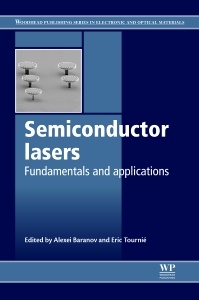Semiconductor Lasers Fundamentals and Applications Woodhead Publishing Series in Electronic and Optical Materials Series
Coordonnateurs : Baranov Alexei, Tournié Eric

Contributor contact details
Woodhead Publishing Series in Electronic and Optical Materials
Preface
Part I: Fundamentals of semiconductor lasers
Chapter 1: Principles of semiconductor lasers
Abstract:
1.1 Introduction
1.2 The basic laser diode
1.3 Key physical concepts
1.4 Absorption and gain in low dimensional semiconductor structures
1.5 Recombination processes
1.6 Gain–current relations
1.7 Temperature dependence of threshold current
1.8 Rate equations
1.9 Future trends
1.10 Acknowledgements
Chapter 2: Photonic crystal lasers
Abstract:
2.1 Introduction
2.2 Lasing threshold of photonic crystal lasers (PhCLs)
2.3 Photonic crystal nanobeam lasers
2.4 Photonic crystal disk lasers
2.5 Conclusion and future trends
2.6 Acknowledgements
Chapter 3: High-power semiconductor lasers
Abstract:
3.1 Introduction: theory and design concept
3.2 Single emitters
3.3 Array concept for power scaling
3.4 Conclusion and future trends
Chapter 4: Semiconductor laser beam combining
Abstract:
4.1 Introduction to laser beam combining
4.2 Experiments on external cavity broad-area laser diode arrays
4.3 Modeling the dynamics of a single-mode semiconductor laser array in an external cavity
4.4 Conclusion
4.5 Acknowledgments
Chapter 5: Ultrafast pulse generation by semiconductor lasers
Abstract:
5.1 Introduction
5.2 Gain-switching
5.3 Important developments in gain-switched semiconductor lasers (SLs)
5.4 Q-switching
5.5 Mode-locking (ML) in semiconductor lasers: an overview
5.6 The main predictions of mode-locked laser theory
5.7 Important tendencies in optimising the ML laser performance
5.8 Novel mode-locking principles
5.9 Overview of applications of mode-locked diode lasers
5.10 Conclusion
5.11 Acknowledgements
Part II: Visible and near-infrared lasers and their applications
Chapter 6: Nonpolar and semipolar group III-nitride lasers
Abstract:
6.1 Introduction
6.2 Applications of group III-nitride lasers
6.3 Introduction to properties of III-nitrides
6.4 Optical properties of nonpolar and semipolar III-nitrides
6.5 Substrates, crystal growth and materials issues
6.6 Optical waveguides and loss
6.7 Fabrication techniques
6.8 Nonpolar and semipolar laser history and performance
6.9 Future trends
6.10 Sources of further information and advice
Chapter 7: Advanced self-assembled indium arsenide (InAs) quantum-dot lasers
Abstract:
7.1 Introduction
7.2 High-density and highly uniform InAs quantum dots
7.3 Quantum-dot Fabry–Pérot (FP) and distributed-feedback (DFB) lasers for optical communication
7.4 Quantum-dot FP and DFB lasers for high-temperature application
7.5 QD Laser, Inc
7.6 Silicon hybrid quantum-dot lasers
7.7 Conclusion
7.8 Acknowledgements
Chapter 8: Vertical cavity surface emitting lasers (VCSELs)
Abstract:
8.1 Introduction
8.2 Device structure
8.3 Vertical cavity surface emitting laser (VCSEL) optical performance
8.4 Conclusion
8.5 Acknowledgements
Chapter 9: Semiconductor disk lasers (VECSELs)
Abstract:
9.1 Introduction
9.2 Principles of operation
9.3 Intracavity frequency control
9.4 Pulsed operation
9.5 Future trends and applications
9.6 Sources of further information and advice
Chapter 10: Hybrid silicon lasers
Abstract:
10.1 Introduction
10.2 Fundamentals of Si lasers
10.3 Hybrid Si laser-based photonic integrated circuits
10.4 Conclusion
Part III: Mid- and far-infrared lasers and their applications
Chapter 11: Gallium antimonide (GaSb)-based type-I quantum well diode lasers: recent development and prospects
Abstract:
11.1 Introduction
11.2 Diode lasers operating below 2.5 μm
11.3 Diode lasers for spectral range above 3 μm
11.4 Metamorphic GaSb-based diode lasers
11.5 Acknowledgements
Chapter 12: Interband cascade (IC) lasers
Abstract:
12.1 Introduction
12.2 Operating principle of interband cascade (IC) lasers
12.3 Early development and challenges
12.4 Recent progress and new developments
12.5 Future trends and conclusion
12.6 Acknowledgments
Chapter 13: Terahertz (THz) quantum cascade lasers
Abstract:
13.1 Terahertz quantum cascade laser technology
13.2 Waveguides and photonic structures
13.3 Stabilisation, microwave modulation and active mode-locking of terahertz quantum cascade lasers
Chapter 14: Whispering gallery mode lasers
Abstract:
14.1 Introduction to whispering gallery modes (WGM)
14.2 WGM in electrodynamics
14.3 Semiconductor WGM lasers
14.4 Light extraction from a WGM resonator
14.5 Conclusion
14.6 Acknowledgements
Chapter 15: Tunable mid-infrared laser absorption spectroscopy
Abstract:
15.1 Introduction
15.2 Laser absorption spectroscopic techniques
15.3 Quantum-cascade lasers (QCLs) for trace gas detection
15.4 Specific examples of QCL-based sensor systems
15.5 Conclusions and future trends
Index
Eric Tournié is a professor of electrical engineering and photonics at the University of Montpellier and a senior member of Institut Universitaire de France (IUF).
He is an expert on the epitaxial growth of compound semiconductor heterostructures and devices. His interest has always been the development of new nanostructures for applications in optoelectronic devices.
- Provides a comprehensive review of semiconductor lasers and their applications in engineering, biology, chemistry and medicine
- Discusses photonic crystal lasers, high power semiconductor lasers and laser beams, and the use of semiconductor lasers in ultrafast pulse generation
- Reviews applications of visible and near-infrared emitting lasers and mid- and far-infrared emitting lasers
Date de parution : 04-2013
Ouvrage de 664 p.
15.5x23.2 cm



